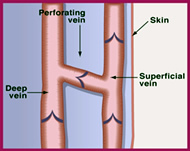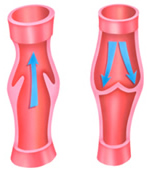
University Vascular Associates
Marina Laser Vein Center
Marina Laser Vein Center
4560 Admiralty Way - Suite 356
Marina Del Rey, CA 90292
Call us at: (310) 823-7314
Welcome to Marina Laser Vein Center! Our fellowship-trained vascular surgeons utilize the most advanced minimally invasive treatment of vein disease.
We look forward to meeting you and providing you with the best possible care!
 The body has two networks of veins in the arms and legs, the deep and superficial venous systems. The superficial veins close to the skin normally bring blood back to the heart by eventually connecting with the deep veins that lie close to nerves, arteries, and bones. In fact, the two systems run parallel to each other, resembling a ladder. The rungs of the ladder are the perforator veins that normally drain blood from superficial to deep. If the one-way valves in the perforator veins are broken, blood may flow from deep to superficial, causing high pressure in the superficial venous system.
The body has two networks of veins in the arms and legs, the deep and superficial venous systems. The superficial veins close to the skin normally bring blood back to the heart by eventually connecting with the deep veins that lie close to nerves, arteries, and bones. In fact, the two systems run parallel to each other, resembling a ladder. The rungs of the ladder are the perforator veins that normally drain blood from superficial to deep. If the one-way valves in the perforator veins are broken, blood may flow from deep to superficial, causing high pressure in the superficial venous system.Symptoms
High superficial venous pressures from incompetent perforators may cause varicose veins or skin ulcers, particularly in the lower leg and ankle.Incidence and Causes
Nearly 70% of all women and 30% of men will develop some type of venous disorder. Incompetent perforator veins may be the source of reflux causing varicose veins or skin ulcers. If the patient has pain, swelling, or an ulcer, a duplex ultrasound is performed to make a complete diagnosis. The ultrasound will determine the presence of truncal/saphenous insufficiency, as well as perforator incompetence.
Contributing factors include:
- Heredity
- Pregnancy
- Hormonal changes
- Being Overweight
- Standing or sitting for prolonged period of time
- Advancing Age
- Trauma
Anatomy
Since humans walk upright, our leg veins contain valves that normally allow one-way blood flow from the feet up to the heart. They close and prevent backward blood flow when resting in the standing position. When the valves fail, there is backward blood flow (venous “insufficiency” or “reflux”) that results in very high venous pressure. Because veins have very thin walls, this high pressure causes significant stretching and elongation – resulting in the formation of varicose and spider veins.


Pre-Procedure Protocol
The location and malfunction of perforator veins will be determined by duplex ultrasound. If a perforator vein is found to be feeding a large varicose vein or is underlying a skin ulcer, then treatment will be recommended.Depending on the size and depth of the perforator, one of two treatments will be provided. If the vein is short or small, then foam sclerotherapy injection under ultrasound guidance is performed. A small needle enters the perforator vein and a small amount of foam sclerosant material is injected. If the perforator vein is longer or larger, then a small catheter is inserted, and laser energy is used to seal the vein shut. Both treatments obliterate the source of high venous pressure.
Post Procedure Protocol
Once the procedure is complete, a compression stocking is placed on the treated leg for 7 days. Under normal conditions the patient may return to work the following day.The following are common physician recommendations:
- Wear compression stockings for a period of one week all the time, then 3 more weeks during the day
- Abstain from high impact activities such as running or step aerobics for a period of 3 weeks
- Walking is encouraged, as it will aid in the healing process
A repeat ultrasound will be done in 3-7 days to check the deep leg veins, and again in 4 weeks to ensure that the treated veins are sealed. Occasionally, a treated vein will reopen, requiring either repeat injection of foam sclerotherapy or repeat laser treatment. The vast majority of treated veins are sealed shut at 1-year follow-up.
As with any procedure, some mild side-effects might occur. You may experience a slight redness to your skin tone in the treated area, which will fade away within a few days. You might also notice a slight swelling in the treated area.


